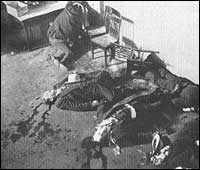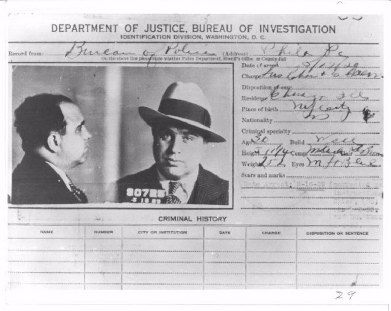|
|
Upon
his death, The New York Times said of Al Capone that he was
"the symbol of a shameful era, the monstrous symptom of
a disease which was eating into the conscience of America. Looking
back on it now, this period of Prohibition in full, ugly flower
seems fantastically incredible. Capone himself was incredible,
the creation of an ugly dream" (Bergreen,
19). As these words suggest, Capone's story seems to provide
a near perfect case study in considering the coming of gangsterhood
into Chicago in the age of Prohibition. His story illuminates
the surrounding issues of immigration and ethnicity, the corruption
of both the government and its law enforcement agencies on the
one hand, and the gangsters, who thrived on bootleg alcohol
sales, racketeering, prostitution, and gambling on the other.
With Capone, these ideas have reached mammoth proportions-he has
been turned by our culture into the symbol of an evil force
thriving through his historical moment of institutional weakness
and confusion. |
Alfonsi Capone came to
America as a young child in 1894 with his family, from Naples, just
one of 42,977 Italians to immigrate that year (Bergreen,
23). His family moved to Brooklyn, which Capone eventually made
his stomping grounds for the beginning of a life in crime. As a
teenager, Capone was recruited by Johnny Torrio, one of the most
successful gangsters on the East Coast, for whom Capone did small
favors and errands. In his early adolescence, Capone contracted
Syphilis, likely from one of a number of the neighborhood prostitutes
he slept with (Bergreen, 45). The
symptoms disappeared a few weeks after the contraction, and Al assumed
the disease had been cured somehow. The disease, however, had merely
gone underground, as is the case with Syphilis, and formed a gradually-increasing
dementia which is likely one of the causes for Capone's frequent
outbursts of violence, for which he became notorious (Bergreen,
85).
Soon after, still a young man,
Al secured a position working Frankie Yale at a bar called the Harvard
Inn. He was involved in a bar fight with another Italian man, whose sister
Al told that she had "a nice ass." The man was furious and sliced
across Al's face three times, giving him the large scars for which he
was nicknamed "Scarface."
|

Frankie
Yale (Bardsley).
|
After
a short stay in Baltimore, Capone moved to Chicago, where Johnny
Torrio had just inherited the throne as crime-king of the city
after his boss, "Big Jim" Colosimo, was murdered by
Frankie Yale in 1920. Torrio offered Al and his brother positions
managing two brothels, and after a year, Al was put in charge
of the Four Deuces, Torrio's head of operations. At the Four
Deuces, it is said, the basement was used to torture men with
information valuable to the Torrio-Capone force, while upstairs
prostitutes offered their services to politicians and mobsters
alike (crimelibrary.com). |
|
After the election of
reformer William Dever to the mayor's office of Chicago, it became
increasingly difficult to run rackets in Chicago, and so the Torrio-Capone
camp decided to move operations to the suburb of Cicero. In Cicero,
Al installed his brothers into positions of power, Frank taking
charge of the local government and Ralph opening a brothel. Al opened
a gambling joint. The Capones eventually gained control of the city,
but his brother Frank was shot and killed by the Chicago Police
Department while he was bullying a number of election workers on Election
Day.
|
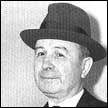
Torrio
(Bardsley).
|
|
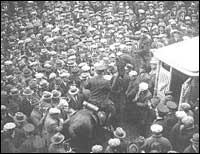
Dion's
Funeral (Bardsley).
|
Torrio
was eventually tricked into capture during a meeting with another mobster,
Dion O'Banion, at an illegal brewery to purchase stocks in the building.
Torrio went to jail and O'Banion bragged about the deception. O'Banion
was assassinated. With him out of the picture, Capone
took over his bootlegging territory. After an assassination attempt
by O'Banion's men, Torrio went to jail for nine months for bootlegging
due to the O'Banion setup, and afterwards abandoned his life of crime.
Capone inherited the crime arena Torrio built. |
Capone continued to expand
his bootlegging empire. In a word, he met the immense demand for
alcohol (almost all adults drank bootleg alcohol during Prohibition)
with an equally large supply (Bergreen,
529). On a trip to New York to have his son's chronic ear infections
treated with surgery, Capone met with his old accomplice Frankie
Yale to ensure the purchase of a large quantity of Canadian Scotch
whiskey. Throughout the next years, Capone met with increasing pressure
from law enforcement agencies and from outside crime operations. He continued
to expand his empire outside of the realm of bootlegging to
insure that he would have a profit-base if Prohibition was ever rescinded.
The violence reached a peak of epic proportions on Valentine's Day,
1924. Capone and his friend Jack McGurn planned an assassination
attempt on Bugs Moran, who had tried to murder McGurn twice. The
plan seemed to go off without a hitch--Capone's men, dressed as police
officers, lined a group of bootleggers they assumed to contain Moran
against a wall, as if they were conducting a raid. The two "officers"
ran machine guns at the men and led two of Capone's men off the
site as if they were captured bootleggers. Unfortunately, Bugs Moran
wasn't in the group.
After the St. Valentine's
Day massacre, Capone gained unprecedented amount of press hype;
he became a national emblem, a celebrity. The attention of Washington
was gained, and Andrew Mellon, Hoover's Secretary of the Treasury,
conducted an investigation designed to pin income tax evasion and
bootlegging on Capone once and for all. He was eventually arrested
outside a movie theater in Philadelphia for holding a concealed
weapon. He was released from jail early in 1930, and went back later
that year, the investigation having sufficient evidence to convict
him of income tax evasion. They turned away from any more serious
prosecution in large part because they feared the man-- he had placed
a $50,000 ransom on each of the betraying bookkeepers' heads ( see http://members.fortunecity.com/moran9/id59.htm).
He was eventually sentenced to eleven years in prison, which he
served at Alcatraz.
|
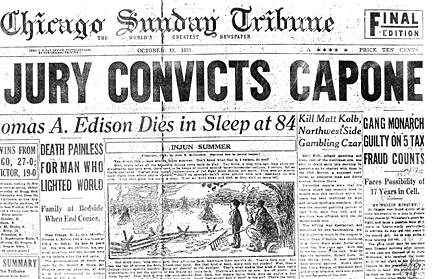
Newspaper
article announcing the conviction of Capone (Bardsley).
|
After his release, he stayed at his enormous villa in Palm
Springs, his health continually deteriorating. He died of
a heart attack in 1947 at the age of 48. For
more on Al Capone, including analysis of Capone's contributions
to organized crime, how he changed the city of Chicago, and
how he forever changed organized crime, click
here.
|

|
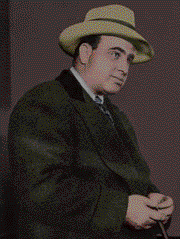 Al Capone
Al Capone 


